Thermal analysis
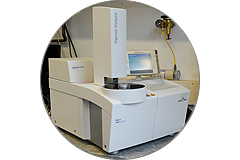
DSC 2 STARe
The DSC 2 STARe from Mettler Toledo has an autosampler and a cryostat and allows measurements to be carried out in the temperature range from –50 to 450 °C (accuracy: ± 0.2 K, precision: ± 0.02 K, resolution: 0.01 µW). Due to the high-pressure measurement option (use of high-pressure resistant sample crucibles), samples can also be analyzed in which (slight) decomposition begins before reaching the melting process.
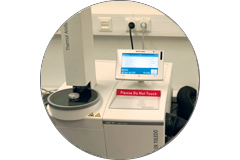
DSC 3+ STARe
The DSC 3+ STARe from Mettler Toledo is equipped with an autosampler, a cryostat and a lid piercing kit and enables measurements in the range from –70 to 700 °C (accuracy: ± 0.2 K, precision: ± 0.02 K, resolution: 0.04 µW), at heating rates of 0.02 – 300 K/min and cooling rates of 0.02 – 50 K/min.
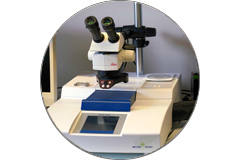
Flash-DSC 1 STARe (Mettler Toledo)
The Flash-DSC 1 STARe from Mettler Toledo enables detailed analysis of structure formation processes in polymers, polymorphic soaps and many composite materials and blends, as well as comprehensive thermal analysis in the shortest possible time. In conventional DSC devices, the sample is measured in a crucible to protect the sensor. This has a significant influence on the measurement due to its heat capacity and thermal conductivity. ... more
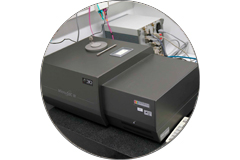
Micro-DSC III
The Micro-DSC III from Setaram allows for a highly senstitive differential scanning calorimetry and calorimetry in the range from –20 to 120 °C at scanning rates from 0.001 – 1.2 K/min (resolution: 0.03 µW, vessel volume: 850 µL). Depending on the selected vessel different experiments can be carried out. The standard batch vessel allows for the analysis of confined solids or liquid samples via temperature scanning or using the isothermal mode. The mixing batch vessel allows for the investigation of two mixing liquid or a solid-liquid mixture in situ.
... more
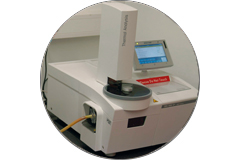
TGA/DSC 3+ STARe
The TGA/DSC 3+ STARe thermal analysis system from Mettler Toledo is equipped with an autosampler and enables thermal analysis in the range from 18 to 1100 °C (resolution: 1 µg, accuracy: ± 0.25 K, precision: ± 0.15 K), at heating rates of 250 K/min and cooling rates of –20 K/min. Air and nitrogen can be used as atmospheres for the investigation of thermal decomposition. The SDTA HT sensor enables the simultaneous detection of melting processes.
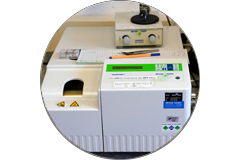
TGA/SDTA851e
The TGA/SDTA851e from Mettler Toledo enables thermogravimetric analysis in the range from 18 °C to 1100 °C (resolution: 1 µg, accuracy: ± 0.25 K, precision: ± 0.15 K), using nitrogen or air as atmosphere. Compared to the TGA/DSC 3+ STARe thermal analysis system, the TGA/SDTA851e does not have an autosampler.
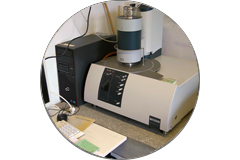
STA 449 F3 Jupiter
The STA 449 F3 Jupiter from Netzsch enables the simultaneous investigation of e.g. melting/crystallization processes, polymorphic transformations and glass transitions as well as the determination of thermal stability. Using a silicon carbide furnace, measurements can be carried out in the range from 25 °C to 1550 °C, at heating/cooling rates of 0.1 K/min up to 50 K/min (TG resolution: 1 µg, DSC resolution: 0.5 – 1 µW).
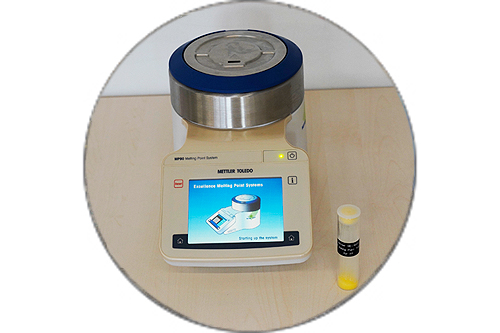
MP90 Melting point meter
The MP90 melting point meter from Mettler Toledo allows for the determination of the melting point in the range from 20 °C to 400 °C (accuracy: ± 0.2 °C (ranging from 30-200 °C), ± 0.5 °C (ranging from 200-400 °C)). At heating rates of 0.1 to 20 K/min, the melting point is determined by reflected light observation and transmitted light measurement.
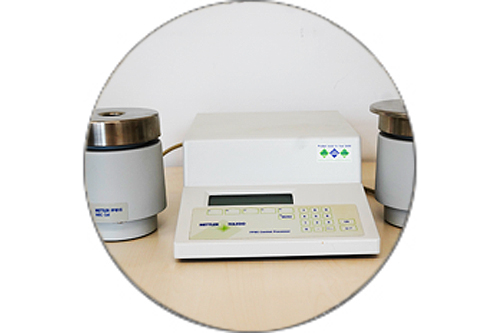
FP900 thermal analysis system for the determination of the dropping point and cloud point
The FP900 thermal analysis system from Mettler Toledo enables measurements up to 375 °C at heating rates of 0 – 20 K/min. The system has an FP81C MBC unit for recording thermooptical changes to determine the melting point, boiling point and cloud point of e.g. surfactants. The sample is transferred into a glass tube (1 – 3 mg or 50 – 80 µL of substance) and illuminated by a light bulb via a light guide. ... more

